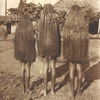Children as Protagonists in Colonial History: Watching Missionary Photography
DOI:
https://doi.org/10.18352/bmgn-lchr.10869Abstract
Although researchers have been pointing to the central position of children in colonial ‘civilising’ projects for years, colonised children remain a historical population that is notably hard to research. This article engages colonised children as central historical actors, by using a collection of missionary photographs taken in Dutch New Guinea (present-day West Papua) between 1905-1925 to study Marind children’s lived experiences and changing positions in a society increasingly dictated by Dutch colonial governance. By applying Ariella Azoulay’s method of ‘watching’ photography, in other words by examining the temporal and spatial dimensions in which the participants in the event of photography moved and interacted, this article aims to approach photographed children as protagonists in colonial history. This approach offers contrasting perspectives to the dominant missionary discourse in the textual archive in which children constitute a marginal and passive presence. Photographs not only have the power to make children visible and transform faceless masses into individuals, but – crucially – allow for a historical analysis centred around children’s movements, actions, and bodies. Children and their bodies – where they were located, which skills they had to learn, the clothes they wore – were the subject of decades-long Dutch colonial policy. Photographs are an indispensable source for recognising and understanding the implementation of this policy as well as colonised children’s responses to it. Watching photography allows historians to see and study young individuals whose lives were in no way marginal, and should be brought into focus in colonial history.Onderzoek heeft uitgewezen dat kinderen een centrale positie innamen inkoloniale ‘beschavingsprojecten’ en daarin uiteenlopende rollen vervulden. Niettemin is de aanwezigheid van kinderen in koloniale archieven vaak gering, anoniem en indirect en blijven gekoloniseerde kinderen bijgevolg een moeilijk te onderzoeken historische groep. Dit artikel beoogt om gekoloniseerde kinderen als historische actoren centraal te stellen, door middel van een analyse van een collectie foto’s gemaakt door missionarissen in Nederlands Nieuw-Guinea (het huidige West-Papua) tussen 1905-1925. Het doel is om de leefwerelden en de veranderende sociale posities te bestuderen van kinderen in een samenleving die in toenemende mate werd gedicteerd door het Nederlandse koloniaal bestuur. Met behulp van Ariella Azoulay’s methode van ‘watching photography’, waarmee zij bepleit om de temporele en ruimtelijke dimensies waarbinnen de deelnemers aan het fotografisch proces zich bewogen in ogenschouw te nemen, worden gefotografeerde kinderen als protagonisten in koloniale geschiedenis geconcipieerd. Deze benadering contrasteert met het dominante discours in het tekstuele missiearchief, waarin kinderen een marginale rol spelen en als volgzaam gepresenteerd worden. Foto’s maken kinderen niet alleen zichtbaar en als individuen identificeerbaar, maar maken daardoor ook historische analyses mogelijk van de verplaatsingen, de handelingen en de lichamen van de kinderen. De lichamen van jonge mensen – waar ze zich bevonden, de vaardigheden die ze leerden, de kleding die ze droegen – waren vele jaren de inzet van Nederlands koloniaal bewind. Foto’s zijn een onmisbare bron als we dit koloniale beleid, maar ook de respons van de gekoloniseerde kinderen zelf hierop, willen kennen en begrijpen. De methode van ‘watching photography’ maakt een historische analyse mogelijk met deze jonge individuen, wier leven op geen enkele manier marginaal was en die een centrale plaats in de koloniale geschiedschrijving zouden moeten innemen.
Downloads

Published
Issue
Section
License
Copyright (c) 2021 BMGN - Low Countries Historical Review

This work is licensed under a Creative Commons Attribution-NonCommercial 4.0 International License.
Authors who publish with this journal agree to the following terms:
a) Authors retain copyright and grant the journal right of first publication with the work simultaneously licensed under a Creative Commons Attribution 4.0 International (CC BY 4.0) that allows others to share the work with an acknowledgement of the work's authorship and initial publication in this journal.
b) Authors are able to enter into separate, additional contractual arrangements for the non-exclusive distribution of the journal's published version of the work (e.g., post it to an institutional repository or publish it in a book), with an acknowledgement of its initial publication in this journal.
c) Authors are permitted to post their work online (e.g., in institutional repositories or on their website) prior to and during the submission process.
Authors are explicitly encouraged to deposit their published article in their institutional repository.







